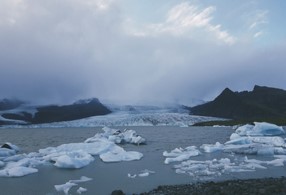As is logical from the name of the process, climate change describes the change of the average weather conditions, or climate, over a long period of time. Generally, the term “climate” can be used to describe the average weather conditions of a region if these conditions last for at least 30 years. Therefore, seasons, for example, are not considered to be climate changes.
Our planet has undergone multiple climate changes throughout its history. Some of these changes were caused by catastrophic events, like a collision with a meteorite, which supposedly caused the Ice Age and the annihilation of most of the then-existing life-forms. Other changes were the result of evolution of the life-forms of the planet. The current nitrogen-oxygen atmosphere of the Earth was formed as a result of evolution of primitive organisms that started to produce O2 as a waste product of their life-sustaining activities. The creation of the oxygen atmosphere has dramatically changed Earth’s climate. It has also killed almost all the life-forms that existed at the time, as oxygen was poisonous to them.

The current situation
If climate change has always been part of the planet’s life-cycle, why are we suddenly so concerned about it? The answer to this question is rather simple. As mentioned above, the previous climate changes have usually destroyed most of the life-forms existing on Earth before those climate changes took place. Our species are adapted to survive in the current climatic conditions of the Earth, therefore, when we are worried about the climate change – we are worried about our own survival.
Moreover, the humanity is currently the main driver of climate change. This basically means that we are trying to kill ourselves with our own hands. When people talk about protecting the environment or nature from climate change, what they really talk about is protecting ourselves. Nature will always find a way, just like it had multiple times in the past. New ecosystems will be created and life on Earth will eventually come to a balanced state again. The problem is that that new world will not be able to accommodate us, humans, in it.
The signs of climate change
Among the most obvious signs of climate change are:
- Increase or decrease of the average temperatures;
- Changes of the prevailing wind directions;
- Changes in the water cycle.
These factors influence the amount of clouds formed above the surface of the Earth, and, therefore, the amount of precipitation – another noticeable sign of climate change.
The factors listed above greatly influence all ecosystems on Earth. The distribution of wetlands and deserts changes, the areas that used to have enough water may become dry and stop supporting the vegetation. Other areas may, on the contrary, become flooded, due to the increased levels of water in the rivers. The size of the polar icecaps and glaciers is changing as well.
Among the long-term consequences of climate change are changes in sea currents’ strengths and directions, general sea level rise and an increase or decrease in salinity (salt content) of sea water.
Climate change became obvious in the 20th century when the global temperature rise became so significant that it became impossible to ignore the problem any longer.
As the problem of global warming becomes more and more obvious, more and more information about climate change becomes available.